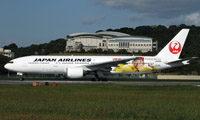Cover Story
Back from the dead
Little more than 15 months ago Japan Airlines reintroduced its iconic tsurumaru livery, a red-crowned crane with its wings extended in full flight. Some pundits are suggesting it should have been the phoenix. In the face of immense challenges JAL has risen from the ashes.
June 1st 2012
There have been some spectacular failures over the years in the Asia-Pacific airline family, but few as dramatic as the near downfall of Japan Airlines. The carrier that symbolized Japan’s rise as a modern industrial power did the unthinkable in January 2010, filing for bankruptcy protection as it creaked and groaned under more than $25 billion of debt. Read More »
 |
| Japan Airlines: a third of its staff left under rehabilitation |
The racking up of huge losses after an expansion into unprofitable routes was worsened by the 2008 financial crisis. JAL had also faced increasing domestic competition from rival All Nippon Airways and from regional competitors.
The writing had been on the wall for years. Operating with a top heavy bureaucratic structure, it survived through repeated government bailouts. Under the long-governing Liberal Democratic Party, JAL was propped up first as a state-owned airline and then, after privatization in 1987, with generous cash injections.
It would have been forced to stop operating in 2010 except for another government infusion of some $6.6 billion, enabling it to keep planes in the air.
Today, analysts agree the key to JAL’s turnaround was the new management team that took over as the airline entered bankruptcy protection. The then Prime Minister, Yukio Hatoyama, persuaded one of Japan’s most prominent and respected business figures, 79-year-old Kazuo Inamori, to come out of retirement and perform a miracle.
Inamori, the founder of Kyocera Corp, a major high-tech company manufacturing a range of products including cell phones and solar power equipment acted quickly and promoted 54-year-old, Masaru Onishi, a 32-year JAL stalwart to president (he became JAL chairman in February this year).
They took no prisoners. A massive $10 billion restructuring programme was launched. After de-listing from the stock market, a third of the workforce was eliminated, employee benefits were cut, 103 aircraft were grounded and 49 loss-making routes were closed, translating into a 40% international and 30% domestic network reduction.
It proved to be life-saving surgery. In March last year, JAL exited bankruptcy protection. It had paid off its creditors and secured more than $3 billion in new loans and capital.
Ironically, it was that same month when a huge earthquake hit Japan, triggering a cataclysmic tsunami and subsequent nuclear crisis. But despite seeing its international traffic drop 25% and domestic business plummet 28% in the weeks following the disaster, JAL has continued its strong road to recovery.
Indeed, what 30 months ago was being described as one of Japan’s biggest corporate failures is today a remarkable success story with the reborn JAL posting record profits.